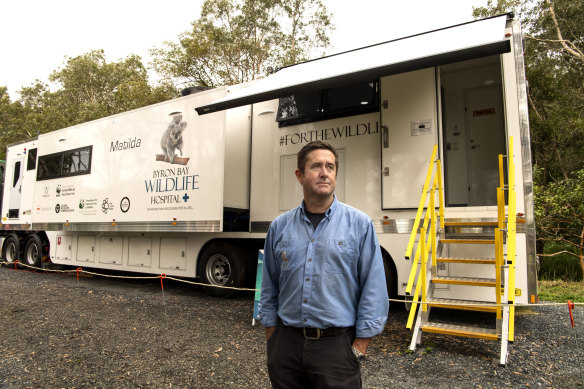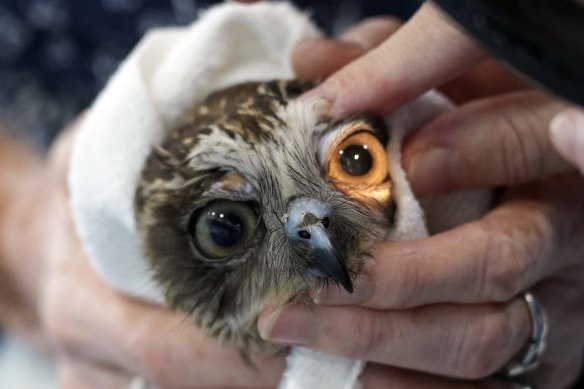Byron wildlife hospital faces closure after government pulls funding promise
By Laura Chung
A NSW animal hospital may be forced to close after a grant earmarked for it by the previous government was pulled, potentially leaving thousands of native animals in the region vulnerable.
The Coalition government announced in February that $6 million had been set aside for the Byron Bay Wildlife Hospital over four years, allowing it to provide veterinary care for injured, diseased, orphaned and displaced wildlife. The funding was set to begin on July 1.

Byron Bay Wildlife Hospital chief executive officer Dr Stephen Van Mil says the hospital may face closure if it can’t find replacement funding.Credit: Louise Kennerley
But last month, the Department of Planning and Environment advised the hospital that it would not receive the money.
In a letter seen by the Herald, a department official wrote to the hospital’s chief executive Dr Stephen Van Mil saying the project did not demonstrate value for money from the proposed government investment.
“As you are aware, the NSW Government’s Grants Administration Guide requires all grants to achieve value for money,” the letter reads.
“This must be a key consideration for decision-makers. On the basis of its assessment, the panel recommended that the proposed grant not be approved. The Minister noted this advice and decided to not approve the grant.”

The hospital has helped countless wild animals, including this boobook owl following the floods that smashed the region in 2022.
As part of the hospital’s grant proposal, it commissioned an independent economic impact report that showed it supports 19 jobs in NSW and that it returned $4 of economic output for every dollar the government would have invested under the grant.
Van Mil said when he received the call that the funding had been revoked, he was shocked.
“We’ve worked so hard,” he said. “There were feelings of elation when the funding announcement was made and then devastation when we were advised it was not forthcoming.”
The funding would have allowed the hospital to focus on raising money for special projects, rather than for overheads and operating costs.
“We are going to do everything we can to keep the doors open. We’ve been going for three years and helped thousands and thousands of Australian animals, all free of charge. It would be a massive disservice to animals across the Northern Rivers region not to keep going,” he said.
“If we don’t find funding in the short term to replace what we were expecting [from the grant], we face real closure.”
Since opening in 2020, the hospital has helped more than 4000 animals.
Dr Alex Hynes, a veterinarian and hospital board member, said many vets who look after domestic pets don’t know how to care for wildlife, which is why services such as the Byron Bay one were so important.
“Wildlife hospitals like the one in Byron Bay are essential for us to have any chance of really maintaining a lot of these threatened species long term. They give native animals the best chance of surviving,” she said.
“Handling and treating injured wildlife requires skill and knowledge that is remarkable and rare. The world is watching us and how we look after our wildlife. If we want to give native animals the best chance of survival, we need places like Byron Bay Wildlife Hospital.”
A spokesperson for the environment minister’s office said the previous government had offered the proposed funding to the Byron Bay Wildlife Hospital, subject to assessment as per its grants guidelines.
“The department found that the proposal does not adequately demonstrate value for money from the proposed government investment, as required by the guide. The grant process was conducted in line with the grant guidelines,” the spokesperson said.
“The NSW government continues to support wildlife rehabilitation in the Northern Rivers region through existing programs. Additionally, $3.5 million has been provided to deliver programs under the NSW Koala Strategy to support the wildlife rehabilitation sector, vets and vet nurses, and to improve outcomes for sick and injured koalas.
“We would like to work with the Byron Bay Wildlife Hospital in the future.”
Australia has about 2000 species of flora and fauna on the threatened list, which means they are at elevated risk of extinction.
WWF Australia’s head of regenerative country Darren Grover said that, as Australia looked likely to experience increased fire risk this year because of a looming El Nino weather pattern, it was vital wildlife had a place they could receive care.
“One thing we have noticed is that the wildlife hospitals are spread far and wide and there are large areas where there aren’t wildlife care and treatment facilities available,” he said.
He said despite WWF providing training to countless vets across the country on how to care for wildlife, more systemic issues needed to be addressed, such as habitat destruction and invasive species management.
A guide to the environment, what’s happening to it, what’s being done about it and what it means for the future. Sign up to our fortnightly Clear Air newsletter here.